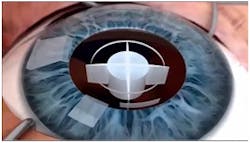Femtosecond laser surgery affected by cavitation bubble dynamics
Sunnyvale, CA--Using a Calmar Cazadero femtosecond laser, researchers in the Biomedical Optics Department of Laser Zentrum Hannover (LZH) have completed research on how cavitation bubbles impact the laser surgical process. The Biomedical Engineering article is entitled "The influence of a spatial and temporal pulse-overlap on the laser tissue-interaction of modern ophthalmic laser systems" and further research details will be presented at SPIE Photonics West 2013 in paper 8579-1 on Monday, February 4 at 8:30 am.
This study by LZH presented a new methodology and analysis of the cavitation bubble dynamics of temporally separated femtosecond laser pulses using time-resolved photography to study the behavior of pulse-to-pulse interaction on laser cut quality of corneal tissue. It found that spatial and temporal overlap of pulses and bubbles can lead to a reduced effectiveness of the available energy for the cutting process, because the energy of subsequent laser pulses can be diffused or even damage surrounding tissue when they interact with cavitation bubbles. The research suggests that optimal cutting occurs by adjusting parameters (pulse energy, cavitation bubble lifetime, pulse interval in multiples of the inverse repetition rate and the resulting temporal pulse overlap) to maximize cutting efficiency while minimizing surrounding tissue damage.
Lead author Nadine Tinne says, "The Cazadero femtosecond fiber laser was an excellent choice, with up to 20 micro-joules of pulse energy and repetition rates up to a Megahertz, and typical pulse widths of less than 500 femtoseconds. The exceptional pulse-to-pulse stability and the clean pulse shape is a prerequisite for the reproducibility of the results described in this article."
Ophthalmologic surgery is a subset of a rapidly growing number of applications that are adopting fiber-based femtosecond laser technology, says Calmar Laser. In ophthalmology, femtosecond lasers are used for cataract procedures (corneal incisions, capsulotomy, and lens fragmentation) in addition to well-established LASIK refractive surgery (flap cutting), and to treat myopia, astigmatism, and hyperopia.
Current lens fragmentation and corneal surgery techniques bring a new set of requirements (as compared to traditional LASIK flap cutting). They require higher pulse energy, shorter pulses, and higher pulse-to-pulse stability for improved cut quality. These features also have the benefits of higher precision, faster processing times, less damage to surrounding tissue, and quicker patient recovery times. Calmar says its Cazadero laser is ideally suited for surgical applications. It is lightweight, compact, air-cooled, and maintenance-free, and has been well received for FDA-approved eye surgery instruments. The Cazadero has a 1 µm wavelength, pulse energies of up to 20 µJ, short typical pulse widths of <400 fs, and eight ready-to-use repetition rates anywhere from 100kHz to greater than 1 MHz. Pulse energy and repetition rates are easily switchable, on the fly, to allow the laser to quickly adapt to a wide range of applications, and the arbitrary pulse picking feature allows complex temporal patterns of pulse sequences to be programmed for any process.
SOURCE: Calmar Laser; http://campaign.r20.constantcontact.com/render?llr=o5wyzvcab&v=001VLboNz7kWENfJHxVBSj4oC6XBPPvcxF8sggSydjjZCjo5eNUpYEsDRyAOrot57VoFs8QIM62YecE5cVebmezN9HulX5bd-V96h4EYjeTh8dqAQnH2bLjeKdLiySHABl8

Gail Overton | Senior Editor (2004-2020)
Gail has more than 30 years of engineering, marketing, product management, and editorial experience in the photonics and optical communications industry. Before joining the staff at Laser Focus World in 2004, she held many product management and product marketing roles in the fiber-optics industry, most notably at Hughes (El Segundo, CA), GTE Labs (Waltham, MA), Corning (Corning, NY), Photon Kinetics (Beaverton, OR), and Newport Corporation (Irvine, CA). During her marketing career, Gail published articles in WDM Solutions and Sensors magazine and traveled internationally to conduct product and sales training. Gail received her BS degree in physics, with an emphasis in optics, from San Diego State University in San Diego, CA in May 1986.
